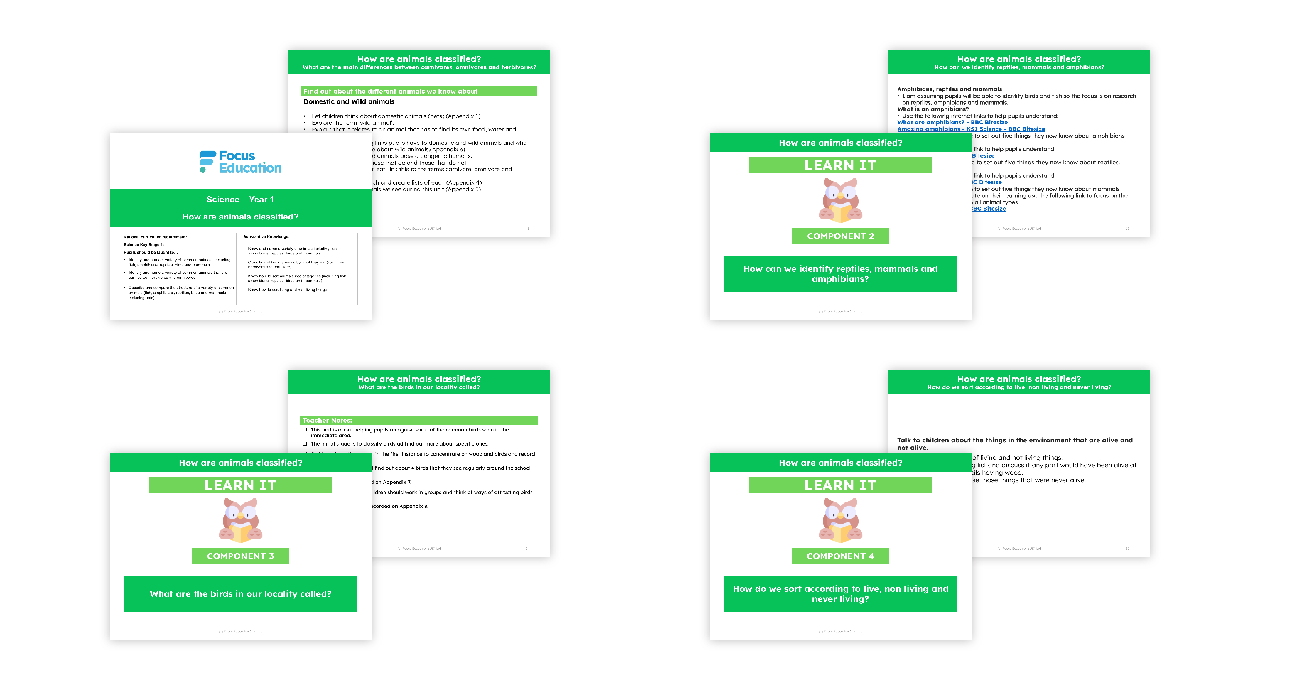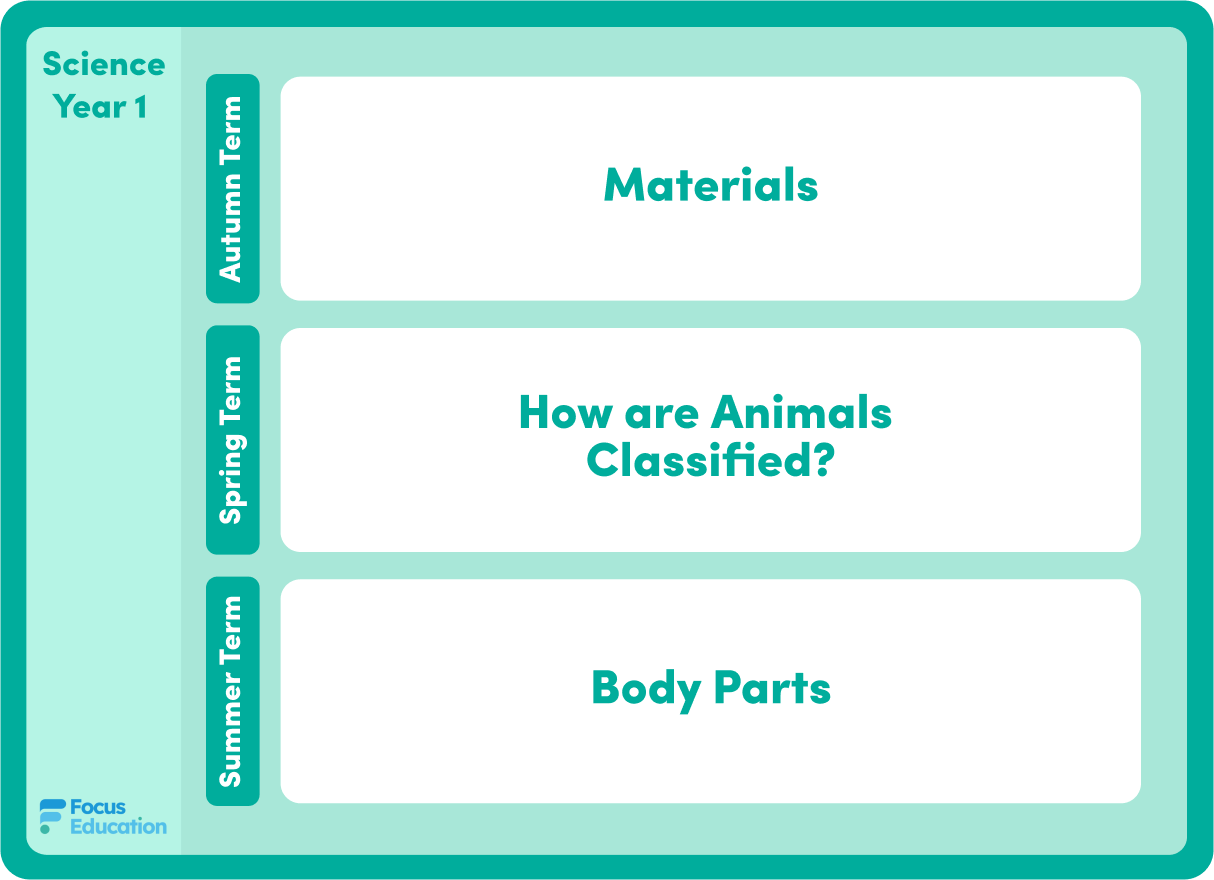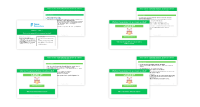How are Animals Classified
Unit
Science
Kindergarten
Focus Education
Science Unit Description
Editable presentation
Group work
Active
Discussion based learning
Kindergarten Science unit, How are Animals Classified from Focus Education. This unit uses an enquiry-approach methodology, lessons are built around a central question in order to build pupil curiosity and motivate learning. How are Animals Classified has been constructed in accordance with the National Curriculum.
Unit contents
Overview Documents

Long-term overview
Resource
Science
Kindergarten
The Long-term overview for the unit How are Animals Classified from Focus Education

Knowledge organiser
Resource
Science
Kindergarten
The Knowledge organiser for the unit How are Animals Classified from Focus Education
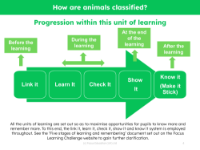
Progression pedagogy
Resource
Science
Kindergarten
The Progression pedagogy for the unit How are Animals Classified from Focus Education
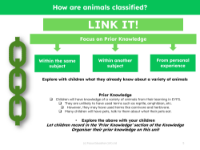
Link it! Prior knowledge
Resource
Science
Kindergarten
Link it! Prior knowledge is the set of initial activities that should be used to introduce the unit How are Animals Classified from Focus Education, it will allow pupils to link the upcoming learning to their existing skills and knowledge
Lessons
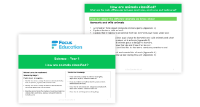
1. What are the main differences between carnivore, omnivore and herbivore?
Lesson
Science
Kindergarten
Kindergarten Science lesson from the unit How are Animals Classified. This lesson uses an enquiry-approach method, and will facilitate students answering the question 'What are the main differences between carnivore, omnivore and herbivore?'

2. How can we identify reptiles, mammals and amphibians?
Lesson
Science
Kindergarten
Kindergarten Science lesson from the unit How are Animals Classified. This lesson uses an enquiry-approach method, and will facilitate students answering the question 'How can we identify reptiles, mammals and amphibians?'
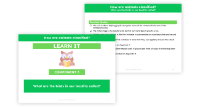
3. What are the birds in our locality called?
Lesson
Science
Kindergarten
Kindergarten Science lesson from the unit How are Animals Classified. This lesson uses an enquiry-approach method, and will facilitate students answering the question 'What are the birds in our locality called?'

4. How do we sort according to live, non-living and never living?
Lesson
Science
Kindergarten
Kindergarten Science lesson from the unit How are Animals Classified. This lesson uses an enquiry-approach method, and will facilitate students answering the question 'How do we sort according to live, non-living and never living?'
Assessment for Learning Resources
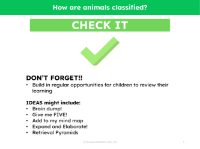
Check it!
Resource
Science
Kindergarten
Check it! is a set of assessment for learning tasks and assessments that should be used to check pupils' understanding of the learning during the course of the unit How are Animals Classified from Focus Education.
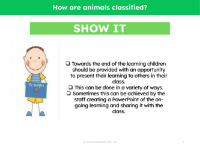
Show it! Group presentation
Resource
Science
Kindergarten
Show it! Group presentation is a group task that should be used to solidify student learning and should be run after the teaching of the lessons contained in the unit How are Animals Classified from Focus Education
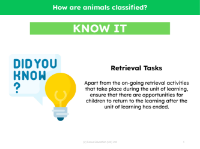
Know it!
Resource
Science
Kindergarten
'Know it! - How are Animals Classified? - Kindergarten' is a resource for assessing pupil knowledge at the end of the Kindergarten unit, How are Animals Classified
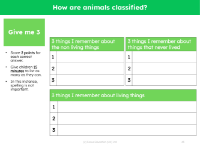
Give me 3 - Living things
Resource
Science
Kindergarten
'Give me 3 - Living things' is a resource for assessing pupil knowledge at the end of the Kindergarten unit, How are Animals Classified
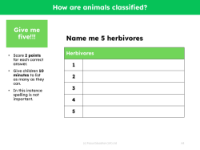
Give me 5 - Herbivores
Resource
Science
Kindergarten
'Give me 5 - Herbivores' is a resource for assessing pupil knowledge at the end of the Kindergarten unit, How are Animals Classified
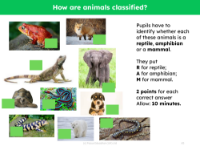
Reptile, Amphibian or Mammal?
Resource
Science
Kindergarten
'Reptile, Amphibian or Mammal?' is a resource for assessing pupil knowledge at the end of the Kindergarten unit, How are Animals Classified
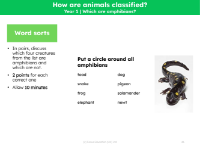
Which are amphibians? - Word sort
Resource
Science
Kindergarten
'Which are amphibians? - Word sort' is a resource for assessing pupil knowledge at the end of the Kindergarten unit, How are Animals Classified
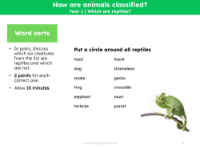
Which are reptiles? - Word sort
Resource
Science
Kindergarten
'Which are reptiles? - Word sort' is a resource for assessing pupil knowledge at the end of the Kindergarten unit, How are Animals Classified

Give me 10 - Birds
Resource
Science
Kindergarten
'Give me 10 - Birds' is a resource for assessing pupil knowledge at the end of the Kindergarten unit, How are Animals Classified

Picture match - Animals
Resource
Science
Kindergarten
'Picture match - Animals' is a resource for assessing pupil knowledge at the end of the Kindergarten unit, How are Animals Classified
Unit contents
Overview Documents

Long-term overview
Resource
Science
Kindergarten
The Long-term overview for the unit How are Animals Classified from Focus Education

Knowledge organiser
Resource
Science
Kindergarten
The Knowledge organiser for the unit How are Animals Classified from Focus Education

Progression pedagogy
Resource
Science
Kindergarten
The Progression pedagogy for the unit How are Animals Classified from Focus Education

Link it! Prior knowledge
Resource
Science
Kindergarten
Link it! Prior knowledge is the set of initial activities that should be used to introduce the unit How are Animals Classified from Focus Education, it will allow pupils to link the upcoming learning to their existing skills and knowledge
Lessons

1. What are the main differences between carnivore, omnivore and herbivore?
Lesson
Science
Kindergarten
Kindergarten Science lesson from the unit How are Animals Classified. This lesson uses an enquiry-approach method, and will facilitate students answering the question 'What are the main differences between carnivore, omnivore and herbivore?'

2. How can we identify reptiles, mammals and amphibians?
Lesson
Science
Kindergarten
Kindergarten Science lesson from the unit How are Animals Classified. This lesson uses an enquiry-approach method, and will facilitate students answering the question 'How can we identify reptiles, mammals and amphibians?'

3. What are the birds in our locality called?
Lesson
Science
Kindergarten
Kindergarten Science lesson from the unit How are Animals Classified. This lesson uses an enquiry-approach method, and will facilitate students answering the question 'What are the birds in our locality called?'

4. How do we sort according to live, non-living and never living?
Lesson
Science
Kindergarten
Kindergarten Science lesson from the unit How are Animals Classified. This lesson uses an enquiry-approach method, and will facilitate students answering the question 'How do we sort according to live, non-living and never living?'
Assessment for Learning Resources

Check it!
Resource
Science
Kindergarten
Check it! is a set of assessment for learning tasks and assessments that should be used to check pupils' understanding of the learning during the course of the unit How are Animals Classified from Focus Education.

Show it! Group presentation
Resource
Science
Kindergarten
Show it! Group presentation is a group task that should be used to solidify student learning and should be run after the teaching of the lessons contained in the unit How are Animals Classified from Focus Education

Know it!
Resource
Science
Kindergarten
'Know it! - How are Animals Classified? - Kindergarten' is a resource for assessing pupil knowledge at the end of the Kindergarten unit, How are Animals Classified

Give me 3 - Living things
Resource
Science
Kindergarten
'Give me 3 - Living things' is a resource for assessing pupil knowledge at the end of the Kindergarten unit, How are Animals Classified

Give me 5 - Herbivores
Resource
Science
Kindergarten
'Give me 5 - Herbivores' is a resource for assessing pupil knowledge at the end of the Kindergarten unit, How are Animals Classified

Reptile, Amphibian or Mammal?
Resource
Science
Kindergarten
'Reptile, Amphibian or Mammal?' is a resource for assessing pupil knowledge at the end of the Kindergarten unit, How are Animals Classified

Which are amphibians? - Word sort
Resource
Science
Kindergarten
'Which are amphibians? - Word sort' is a resource for assessing pupil knowledge at the end of the Kindergarten unit, How are Animals Classified

Which are reptiles? - Word sort
Resource
Science
Kindergarten
'Which are reptiles? - Word sort' is a resource for assessing pupil knowledge at the end of the Kindergarten unit, How are Animals Classified

Give me 10 - Birds
Resource
Science
Kindergarten
'Give me 10 - Birds' is a resource for assessing pupil knowledge at the end of the Kindergarten unit, How are Animals Classified

Picture match - Animals
Resource
Science
Kindergarten
'Picture match - Animals' is a resource for assessing pupil knowledge at the end of the Kindergarten unit, How are Animals Classified
Unlimited access to 30,000+ resources
All subjects
National Curriculum Coverage
Award-winning content
Explore other content in this scheme
Part of a scheme by Focus Education
Other units in this scheme
This website uses cookies to enhance the user experience.
To get more information about these cookies check our

